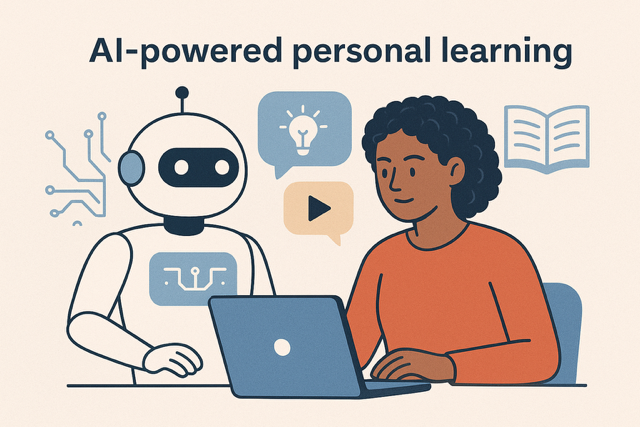
DISCOUNTED EDUCATION PRICING! CALL 1-877-891-8411. We Gladly Accept School Purchase Orders!

Artificial intelligence (AI) is reshaping education, offering tools that adapt to each student’s unique needs. From tailoring lesson plans to providing real-time feedback, AI-powered personalized learning is revolutionizing classrooms worldwide. This article explores how AI is enhancing education, its benefits, challenges, and what the future holds for students and educators. There is an enormous paradigm shift that is happening in the education space.
Personalized learning uses technology to customize education based on a student’s pace, interests, and abilities. AI takes this further by analyzing data to create tailored learning experiences. For example, AI platforms assess a student’s strengths and weaknesses, adjusting content to ensure mastery before moving forward. Tools like adaptive learning software and AI tutors are becoming integral to modern classrooms, offering a dynamic approach to education.
Imagine a student struggling with fractions. An AI system might detect this through quiz responses, then provide targeted exercises and videos to address gaps. Meanwhile, a peer excelling in the same topic could receive advanced challenges, ensuring both progress at their own pace. This individualized approach contrasts with traditional one-size-fits-all methods, making education more inclusive and effective. Tailored and effective learning is about to get a huge boost.
Education is evolving rapidly, with technology at its core. AI-powered personalized learning addresses critical needs in today’s classrooms:
In 2025, with hybrid and remote learning still prevalent, AI’s ability to personalize education remotely is invaluable. It empowers students to thrive in diverse settings, from rural schools to urban districts.
AI is already transforming the world of education, moving far beyond being just a futuristic concept. From personalizing learning experiences to streamlining administrative tasks, artificial intelligence is reshaping how teachers teach and how students learn. Schools, districts, and universities are finding innovative ways to integrate AI into classrooms, not only to improve efficiency but also to unlock new opportunities for creativity, equity, and engagement. Here are some of the most impactful ways AI is currently being used in education:
Platforms like DreamBox and Smart Sparrow analyze student performance in real time. They adjust difficulty levels and suggest resources based on individual progress. For instance, a student struggling with algebra might receive simpler problems, while an advanced learner tackles complex equations. These platforms use machine learning to refine their algorithms, ensuring precision in personalization.
AI tutors, such as those developed by Carnegie Learning, provide instant feedback. A student writing an essay might receive suggestions on grammar or structure from an AI tool, mimicking a teacher’s guidance. Chatbots like Duolingo’s language assistants engage students in conversational practice, adapting to their proficiency levels.
AI-driven virtual reality (VR) tools create immersive learning environments. For example, medical students use AI simulations to practice surgeries, receiving real-time feedback on their techniques. These tools adapt scenarios based on the learner’s decisions, offering a safe space to experiment and learn.
AI doesn’t replace teachers—it empowers them. Tools like Brightspace provide educators with dashboards showing student progress, highlighting areas where intervention is needed. This allows teachers to focus on personalized ai learning and support rather than generic lesson planning.
The advantages of AI in education are profound, impacting students, teachers, and schools:
While promising, AI-powered personalized learning faces hurdles that must be addressed:
AI systems rely on vast amounts of student data to function effectively. This raises questions about how data is stored, used, and protected. Schools must ensure compliance with regulations like FERPA (Family Educational Rights and Privacy Act) to safeguard student information.
Not all schools can afford AI tools, risking a digital divide. Rural or low-income districts may struggle to implement these technologies, potentially widening educational gaps. Initiatives like government grants or open-source AI platforms could help address this.
Effective AI integration requires teachers to be tech-savvy. Many educators need professional development to use AI tools confidently. Without proper training, the benefits of AI may not be fully realized.
AI should complement, not replace, human interaction. Overuse could diminish the role of teachers, who provide emotional support and critical thinking skills that AI cannot replicate.
As AI technology advances, its role in education will grow. Here’s what we can expect by 2030:
For schools looking to adopt AI, a strategic approach is key:
Parents and educators often have questions about AI’s role. Here are answers to common concerns:
A Chicago public school district implemented an AI-based reading program in 2024. Struggling readers used adaptive software that adjusted text complexity based on their skills. By year-end, reading proficiency rose by 20%, and student confidence soared.
A rural school in Montana adopted an AI math platform in 2023. With limited access to specialized teachers, the platform provided personalized lessons, resulting in a 12% increase in math scores across grades.
In Kenya, an open-source AI tutoring app helped students in remote areas learn English. The app’s adaptive lessons led to a 30% improvement in language skills within six months, proving AI’s potential in underserved regions.
Parents play a crucial role in embracing AI in education:
AI-powered personalized learning is not a distant dream—it’s happening now. By tailoring education to each student’s needs, AI is creating more engaging, equitable, and effective classrooms. While challenges like privacy and access remain, thoughtful implementation can unlock AI’s full potential. Schools, teachers, and parents must work together to ensure AI serves as a tool for empowerment, preparing students for a future where adaptability and lifelong learning are key.
As we move toward 2030, AI will continue to transform education, making it more inclusive and impactful. By embracing this technology responsibly, we can ensure every student has the opportunity to thrive.